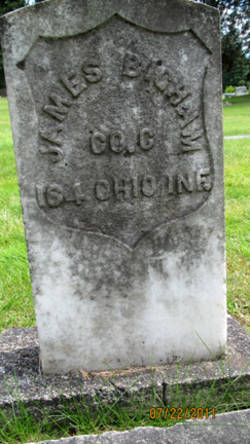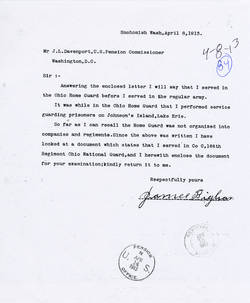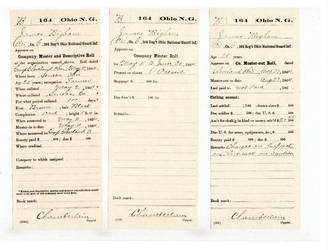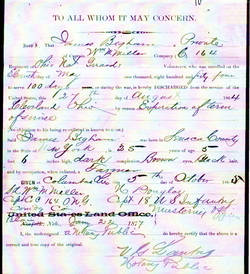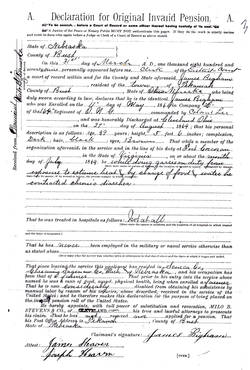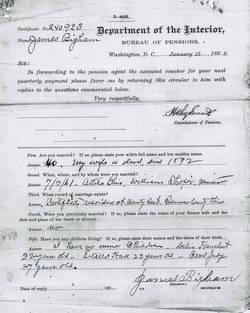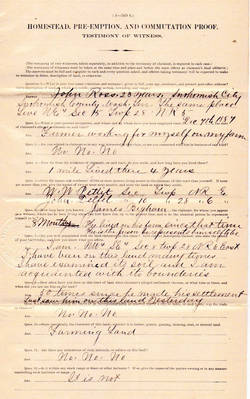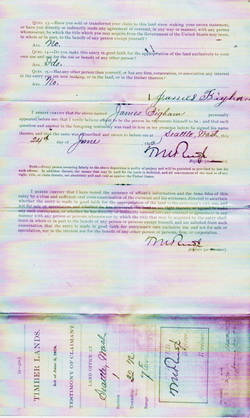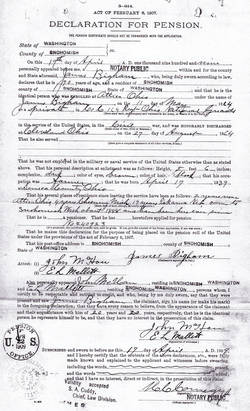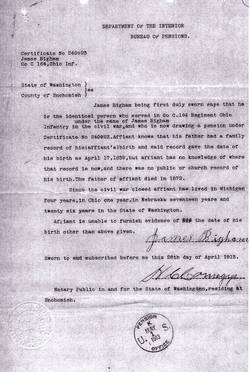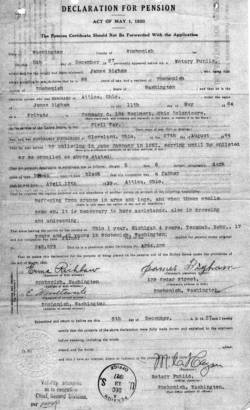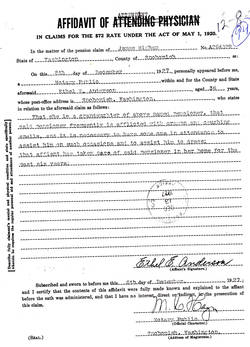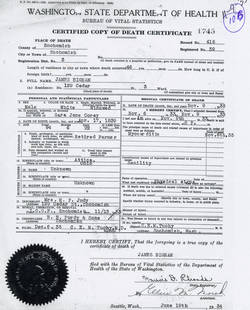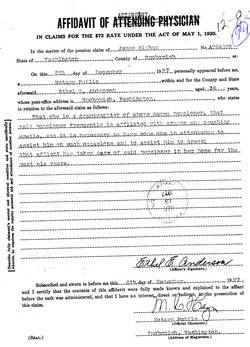James Bigham
Representing: Union
G.A.R Post
- Oliver Morton Post #10 Snohomish, Snohomish Co. WA
Unit History
- 94th Ohio National Guard C
- 164th Ohio National Guard C
Full Unit History
94th OHIO NATIONAL GUARD
Organized: Information Not Avail.
Mustered In: Information Not Avail.
Assimilated Into 164th NATIONAL GUARD VOLUNTEER INFANTRY: May, 1964
164th OHIO (NATIONAL) GUARD VOLUNTEER INFANTRY
Organized: May, 1864 Camp Cleveland, Cleveland, OH
Mustered In: 5/11/64 Camp Cleveland, Cleveland, OH
Mustered Out: 8/27/64 Cleveland, OH
Regimental History
REGIMENTAL HISTORY: (94th)
No definitive documentational information has been located pertaining to this military organization other than it was recruited from Seneca County and that at least one of its assigned duties was the guarding of Confederate prisoners of war confined near Cleveland on Johnson's Island in Lake Erie. In May, 1864 the 94th joined with another Ohio National guard organization to form the 164th (N.G.) Infantry regiment.
REGIMENTAL HISTORY: (164th)
In the spring of 1864 Union General U.S. Grant began amassing forces for a final push into the Confederacy which, a year later, would bring an end to four years of bloody civil war.
In order to place armies comprised of the most "experienced" soldiers into the field, troops were pulled from National Guard units, rear echelon duties and garrison posts. To fill the void created by these pull-outs a number of short terms, primarily non-combat regiments were created and assigned to the emptied positions. The 164th was one such unit.
The 164th, a 100 day eastern theatre regiment was formed in early May, 1864. It was composed of the 49th Regiment Ohio National Guard from Seneca County and the 54th Battalion Ohio National Guard from Summit County. On May 14th, the newly formed regiment departed Cleveland and proceeded to Washington, D.C. reaching that location on the 17th; it was assigned to the defensive forts surrounding that city. During its period of service various elements of the 164th garrisoned forts Smith, Strong, Bennett, Haggarty and others. At the end of its term of enlistment the regiment returned to Cleveland and was mustered out of existence.
Regimental losses: Officers killed or mortally wounded = 0; Officers died of disease, accidents, etc. = 0; Enlisted men killed or mortally wounded = 0; Enlisted men died of disease, accidents, etc. = 18.
Soldier History
SOLDIER: (94th)
Residence: Attica, Attica Township, Seneca Co, OH Age: 22 yrs.
Enlisted/Enrolled: April, 1861 Rank: Pvt.
Transferred: May, 1864
Highest Rank: Ensign*
*NOTE: During the early stages of the American Civil War the army nomenclature of ranks contained one called ensign. At the time it was the lowest of the commission hierarchy, essentially 3rd lieutenant. Before the war ended ensign was dropped by the army and then, as now, applied only as a navy rank.
SOLDIER: (164th)
Residence: Attica, Attica Township, Seneca Co., OH Age: 25.1 yrs.
Enlisted/Enrolled: 5/2/64 Seneca Co., OH Rank: Pvt.
Mustered In: 5/11/64 Camp Cleveland, Cleveland, OH
Mustered Out: 8/27/64 Cleveland, OH
Highest Rank: Pvt.
Family History
PERSONAL/FAMILY HISTORY:
Available documents indicate James Bigham was born in 1838 or 1839 in Attica, Seneca County, Ohio. Ninety four plus years later his obituary would list his birth date as the 17th day of April. Based on that obituary, herein we will accept 1839 as the birth year.
Parents of the newest addition to the Bigham family were Jacob (b. 1803 PA) and Anna (no nee b. 1804 MD). James was the third of at least eight Bigham children. His older siblings were Margaret (b. 1834 PA) and Solomon (b. 1836 PA). As noted by the birth states, sometime between 1836 and ‘39 the Bighams quitted Pennsylvania for Ohio. While Jacob's occupation is not disclosed in available documentation, likely he was a farmer who moved his family westward in search of new, more fertile farmland.
James' younger siblings were: Polly (b. 1839 OH), Susan (b. 1841 OH), Julian (b. 1844 OH), Artemissa "Arthur" W. (b. 1849 OH) and Samuel (b. 1850 OH)
The U.S. census for 1840 found the Bighams in or near the community of Adams located in Darke County, OH. The population tally a decade later placed the family still in Darke County, but does not denote a town or village name. The 1860 census mentions no mention of the family. However, a Jacob Bigham is found in Allen County, Ohio. [Note: On 11/21/61 57 year old Jacob Bigham enlisted as a private in the 40th Ohio Infantry. He was mustered into Co. "K" of that organization on 11/30/61 and served therein until 1/17/63 when, at Louisa, KY, he was discharged for disability.]
We next find mention of James in April, 1861 when, with the onset of civil war in America he volunteered his service to his country via enrolment/enlistment in the Seneca County-based 94th Ohio National Guard. One role this organization would serve prior to its assimilation into larger 164th Ohio Infantry in 1864 was the guarding of Confederate prisoners of war being held on Johnson's Island in Lake Erie not far from the City of Cleveland.
On July 3rd of that same year, in the community of Attica, OH James wed Sarah J. Corey (no. b.d. b. OH). The union would last thirty one years and produce four children before Sarah's untimely death in 1892.
Moving back to the 1860s, James' National Guard unit served in Ohio until May, 1864 when it was called up to the federal level to help form the 164th Ohio (N.G.) Infantry. Upon his entrance into the 164th, Private James Bingham’s vital statistics were noted as follows: Age 25; Height: 5'6"; Eyes: brown; Hair: black; Complexion: dark; Occupation: farmer. Although short in terms of days served, the enlistment would prove to have long-term detrimental health consequences for James.
One of the assignments for the new regiment was to garrison Fort Corcoran, one of the sixty or so fortifications comprising the defences of Washington City. A healthy young man when he departed Ohio for the east, while assigned to duty at the fort James was affected by the extreme heat and humidity of an east coast summer. He was also exposed to changes in the type and quality of food and water he consumed. All these changes resulted in his contracting diarrhoea which became chronic in nature. Not treated for his ailments in a hospital, by the last of July or early August he was considered physically unfit and excused from duty for the balance of his enlistment.
After settling up financial matters with the U.S. Government - he had never been paid during his period of enlistment but owed Uncle Sam $20 for clothing advanced and 58 cents for one knapsack, one haversack and one canteen - James returned home to Attica. His early to mid-September homecoming, however, was not a happy one as he later noted that he was sick to the point where he was unable to do "anything", was doctored all the time, and for a good share of the time could not even get out of bed.
Spring, 1865. James attempted to return to farming. He planted crops and tried to manage them, but once hot weather returned he was plagued anew with repeated attacks of diarrhoea. For this he obtained a prescription from "Doc Jones", but soon found he could not keep up with the mounting doctor and drug store bills.
1866. Another spring. Thinking that a change of climate would help get his health back James and Sarah removed from Ohio to Chesaning in Saginaw County, Michigan. The move was somewhat successful as long as the weather remained cool, but as soon as the hot weather of summer came around he found that if he worked too hard he was once again extremely ill to the point where he "could not earn a man's wages." Still, he later reported that he "worried along (almost) four years there." During this period, in 1867, James and Sarah's first child - daughter Ada D. - was born.
1870. A new decade and a new spring. A new start. Hearing that "the far west" was the place for a poor man, James and family pulled up stakes in Michigan and headed for - of all places - Nebraska. There they wound up near Tekamah and the community of Arizona in Burt County and, on February 10, 1872 he, his wife and four children settled on 40 acres of homestead land.
As of April, 1977 James had been homesteading his Nebraska land. During that time he had constructed a 24' x 38' dwelling that was 1 1/2 story high with a shingle roof, 12 doors and 15 or 16 windows. Additional improvements to the site included digging a well, plowing about 20 acres of land and planting about one acre with fruit trees.
While in Nebraska the James' were blessed with three additional children, all daughters. Minna "Minnie" Pearl was born in 1871. Estelle "Stella"/"Della" M. came into the world in 1874 and Amy Blanche joined the family in 1880. On the negative side James' hopes of resuming the life of a healthy farmer did not materialize.
As noted above a home was built and crops were planted, but with the onset of hot weather it became evident that James could not perform the manual labour necessary to run a farm. While he reportedly struggled to make a go of things for three years, he found, as time went forward, that his plantings would not pay for hired help plus support he and his growing family. As a result of this continuing struggle, on 4/8/79 he began the paperwork process to try and obtain a U.S. Government invalid pension based on the incapacitating spells of diarrhoea which he traced back to his days of Civil War soldiering.
By January, 1880 this pension plea became desperate to the point where James wrote a letter to the U.S. Government with the following: "I tried to work on my own grain last summer, but had to give up in less than a day. I cannot do half an hours work to this day, but I have to do something or starve. This is all I can testify to now." On August 20th of the same year a surgeon's report came to the conclusion that former Union soldier James Bigham's diarrhoea (and resulting piles [hemmeroids]) was chronic, permanent and originated while he was in the service. On an unknown date thereafter, but prior to 6/20/84, James Bigham was granted a $2 per month government stipend retroactive to 8/28/64. On 9/10/84 that amount was increased to $4 per month. At least now the Bigham's had at least a modicum of financial security..............
The Bighams remained in Burt County Nebraska until sometime in 1887 when they departed from their homestead and travelled to the community of Snohomish located in Snohomish County, Washington Territory. Why the drastic move? Climate change? Available documentation does not provide an answer for either question.
There, in late 1888 the Bigham family settled on a new homestead parcel, ownership on which James applied for on 2/10/89. In June of that same year neighbours would sign affidavits attesting that he and his family were permanent residents on the land, had constructed a 16' x 18' house which featured five room, six doors, seven windows plus good roof and floor. Additional improvements on the land included out buildings and fencing. Further, two acres had been plowed for planting and additional six slashed with an eye toward future cultivation. While crops could not initially be planted because of the lateness of the season, plantings were now in the ground. On 6/24/92 James made final application for the 160 acre parcel for which he paid $2.50 per acre.
In late 1889, a Snohomish census would note James as being a "rancher". Under his roof at the time were wife Sarah and daughters, Pearl, Stella and Amy. Later that same year a movement was initiated to increase his pension from $2 to $4 per month. While this process was abandoned shortly thereafter - on 4/20/91 -James' stipend was upped to $12 per month on the basis that beyond chronic diarrhoea and resulting piles, he was also suffering from varicose veins in his left leg and rheumatism in his right shoulder.
While there are no details available, on 2/7/92, Sarah died. She was buried in the Snohomish IOOF Woodlawn Cemetery.
What transpired in James' life in the years immediately following the death of his wife is not known. The next documentation on him appears in the 1900 census of Snohomish, WA. In that tally he is noted as a widower farm helper in the home of Gilbert Malkson and family.
For the years intervening between 1900 and 1920 the only available information pertaining to James deals with increases in his pension payments. On April 22, 1909 the payment was increased from $12 to $14 per month. In 1912, on June 1st it again took a jump to $18 and, finally on April 27, 1914 it was upped to $21.
In 1920 the census found James still in Snohomish, but residing with his widowed daughter Della Kelso. Also in the home were Gary Hanchett (37), Arthur Hanchett (30) and Clarence Hanchett (26). The following year saw him move to the Snohomish home of his granddaughter Ethel E. Anderson.
The latter years of the 1920s found additional physical problems besetting the aging James. A doctor's affidavit of 12/5/27 noted that "during the past few months Bigham has had increasing trou le with cramps in his hands, arms and legs. (He) can't button his shirt or tie (his) shoes. (He has) occasional shap pains in the back and head, (and a) troublesome cough. (He experiences) frequent urination with (a) burning sensation at times.(He has) valvular heart trouble (and) needs assistence dessing and undressing." Three days thereafter an "attendant" affidavit by his granddaughter reported " He frequently afflicted wih cfamps and coughing spells. Necessary to have someone assist him on such occasions and to dress." Also reported were bronchitis-releated coughing spells,and feelings of strangulation. Difficulty getting upfrom a chair. Out of breath easily. Requires aid with dressing, shoes and getting out of the bath tub. Finally on 3/15/28 it was affidavited that James need help from the toilet at time on account of weakness and dizziness. Ordinarilly can feed self, but (this is) difficult at times because of cramps and lameness in arms. Should have an attendant on street because of poor vision and decreptitude."
The census of 1930 in Snohomish would be the old soldier's last. However, it did denote the 90 year old as being the head of the household that was also home for his daughter Minnie P. Judy (59) and her children Earl G. Judy (19) and Carroll R. Judy (11).
James Bigham died in Snohomish, Snohomish County, WA on November 9, 1933. Cause of the 94.6 year old retired farmer's passing was listed as "myocarditis" with "senility" contributing.
His newspaper obituary read as follows:
James Bigham, 94, Civil War Veteran, died Thursday at 8 p.m. at his home, 129 Cedar Street. He was born at Attica O., April 17 1839 and came to Snohomish in 1887.He enlisted in the Ohio Vo. and served until the close of the war. Mr. Bigham was a Member of the Morton Post #10 G.A.R. Surviving him are two daughters, Mrs. Minnie P. Judy of 129 Cedar St, and Mrs. Estella M. Harpool of Marshfield, OR. 25 grandchildren, 26 great grandchildren and three great great grandchildren. Funeral services will be held Monday at 1:30 pm from E.E. Purdy and Songs Chapel. The Rev J.D. Lockard of the Free Methodist Church will officiate. Burial will be at the IOOF Cemetery Woodlawn Cemetery.
His final resting place was, and is, beside Sarah.
Cemetery
Buried at Woodlawn Cemetary Snohomish
